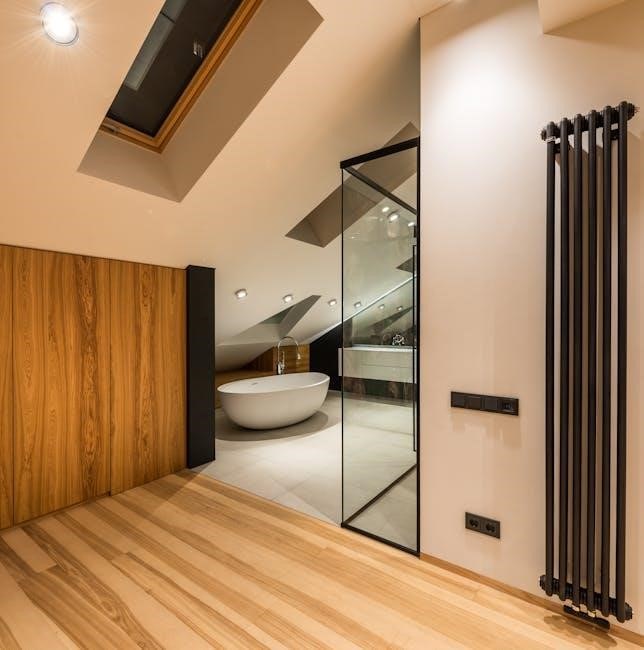A new house walk-through checklist is an essential tool for homebuyers to ensure their new property is in perfect condition. It helps identify issues, verify repairs, and confirm all systems function properly. This comprehensive guide is customizable and downloadable as a PDF, providing a structured approach to inspecting every aspect of the home. By using this checklist, buyers can address concerns before closing, ensuring a smooth transition into their new home and giving them peace of mind.
1.1 Purpose of the Final Walkthrough
The purpose of the final walkthrough is to provide a last opportunity for buyers to inspect their new home before closing. It allows them to identify any remaining issues, verify completed repairs, and ensure all systems and features are functioning properly. This step is crucial for confirming that the property meets agreed-upon standards and addressing any overlooked details. By using a PDF checklist, buyers can systematically evaluate each aspect of the home, ensuring nothing is missed. This process not only protects the buyer’s investment but also provides peace of mind, knowing their new home is ready for occupancy.
1.2 Importance of a Comprehensive Checklist
A comprehensive checklist is vital for ensuring a thorough and organized final walkthrough. It helps buyers systematically evaluate every aspect of the home, from structural elements to minor details, ensuring no issues are overlooked. This tool promotes accountability, as it provides a clear record of the home’s condition before closing. A detailed checklist also streamlines communication between buyers and builders, ensuring all agreed-upon repairs are completed. By using a customizable PDF checklist, buyers can address concerns methodically, protecting their investment and guaranteeing a smooth transition into their new home. It serves as both a practical guide and a legal document.

Exterior Inspection
Exterior inspection ensures the home’s outer structures are in excellent condition. Check the foundation for cracks, walls for damage, roof for missing shingles, and gutters for proper function. Verify windows, doors, and landscaping are intact and functional. This step ensures all exterior elements are visually inspected and noted in your PDF checklist for consistency and clarity.
2.1 Foundation and Structure
Inspect the foundation for cracks or signs of shifting, ensuring it is level and stable. Check the structural integrity of walls, beams, and supports. Verify that all exterior walls are plumb and properly aligned. Look for any water damage or settling issues that could indicate foundation problems. Ensure the grading around the house directs water away from the foundation to prevent future damage. Document any defects or concerns in your PDF checklist for further evaluation or repairs. This step is crucial for ensuring the home’s long-term stability and safety, addressing any potential issues early.
2.2 Walls, Windows, and Doors
Inspect walls for cracks, dents, or uneven surfaces, ensuring they are smooth and properly painted. Check windows for proper sealing, alignment, and functionality, verifying that all panes are intact; Test doors to ensure they open and close smoothly, with no sticking or misalignment. Look for any signs of damage or wear on frames and hinges. Ensure all windows and doors are securely locked and functioning as intended. Document any issues in your PDF checklist for the builder to address before closing. This step ensures all openings are functional, secure, and visually appealing, meeting the standards of your new home.
2.3 Roof and Gutters
Check the roof for any signs of damage, such as missing, loose, or curled shingles, and ensure all flashing around vents and chimneys is properly sealed. Inspect gutters and downspouts for debris, dents, or rust, ensuring they are securely attached and functioning correctly to direct water away from the foundation. Look for any signs of water stains or leaks around the roof’s edges or eaves, which could indicate issues with the gutter system. Verify that all roof components are in good condition and that there are no gaps where pests could enter. Ensure gutters are properly sloped for efficient water flow. Document any findings in your PDF checklist to ensure repairs are made before finalizing the purchase. This thorough inspection will help prevent future maintenance issues and ensure your new home remains secure and dry.
2.4 Landscaping and Irrigation Systems
Examine the landscaping for any unevenness, erosion, or damage to plants and trees. Check the irrigation system to ensure all sprinklers and timers are functioning correctly, with water reaching all areas without over-spray onto hardscapes or buildings. Verify that the system is programmed properly and that there are no leaks or damaged sprinkler heads. Inspect any outdoor lighting connected to the irrigation system for proper operation. Ensure the yard is clean and free of debris, and that all agreed-upon landscaping features are completed. Document any issues in your PDF checklist to address them before finalizing the purchase. Properly working irrigation systems and well-maintained landscaping enhance your home’s curb appeal and functionality. Ensure everything is in order to enjoy your outdoor spaces immediately.
Interior Inspection
Inspect walls, ceilings, and floors for damage, cracks, or uneven surfaces. Ensure all interior surfaces are smooth and properly finished. Check for any defects in paint or materials. Verify that cabinets, countertops, and fixtures are installed correctly and function as intended. Document any issues in your PDF checklist to ensure repairs are addressed before finalizing the purchase.
3.1 Walls, Ceilings, and Floors
Inspect walls, ceilings, and floors for any damage, cracks, or water spots. Ensure all surfaces are even, properly finished, and free from defects. Check for uneven paint application or material inconsistencies. Verify that floors are level and stable, with no signs of movement or damage. Test for any soft spots in wooden floors and ensure tiles are securely fastened. Document any issues in your PDF checklist to address repairs before closing. This step ensures the interior meets quality standards and provides a clear record for necessary adjustments.
3.2 Trim, Molding, and Wood Elements
Examine trim, molding, and wood elements for proper installation and finish. Check for gaps, uneven alignment, or damage to baseboards, crown molding, and door casings. Inspect wood joints, cabinets, and countertops for consistency and quality. Ensure all wood surfaces are free from dents, scratches, or discoloration. Verify that hardware, such as knobs and handles, is securely fastened and functioning properly. Document any defects in your PDF checklist to ensure repairs are addressed before closing. This step ensures all woodwork meets the agreed-upon standards and enhances the home’s aesthetic appeal.
3.3 Cabinets, Countertops, and Fixtures
Inspect cabinets for proper alignment, secure hardware, and smooth operation of doors and drawers. Check countertops for even installation, cracks, or chips. Ensure all fixtures, such as faucets and lighting, are installed correctly and functioning properly. Look for any damage, scratches, or discoloration on surfaces. Verify that all hardware, like knobs and handles, is consistent and securely attached. Document any defects in your PDF checklist to ensure repairs are made before closing. This step ensures all components are in excellent condition and meet the agreed-upon standards for quality and appearance.

Systems and Appliances
Examine all major systems and appliances to ensure proper installation, functionality, and condition. Check for any damage or malfunctions and test their operation. Verify that all components are operational as per the PDF checklist to ensure everything is in working order before finalizing the purchase.
4.1 Plumbing System
Inspect the plumbing system thoroughly to ensure it is leak-free and functioning properly. Check all pipes, fixtures, and connections for visible damage or water spots. Test water pressure by turning on multiple faucets and check for proper drainage in sinks, toilets, and showers. Verify that the water heater is operational and set to the correct temperature. Look for any signs of leaks under sinks, around appliances, and near water supply lines. Ensure all plumbing fixtures are installed correctly and functioning as intended. Document any issues or needed repairs for further action.
4.2 Electrical System
Inspect the electrical system to ensure all components are safe and functional. Test every outlet, switch, and fixture to confirm proper operation. Check circuit breakers to ensure they are correctly labeled and functioning as intended. Verify that all light fixtures, ceiling fans, and appliances are working without flickering or unusual warmth. Test GFCI outlets to ensure they trip correctly when needed. Look for any exposed wires, loose connections, or damaged outlets. Ensure all electrical panels are secure and free from rust or damage. Document any issues or malfunctions for immediate attention or repair.
4.3 HVAC System
Inspect the HVAC system to ensure it operates efficiently and safely. Check for any leaks in ducts or connections and verify proper airflow in all rooms. Test the thermostat to confirm accurate temperature control and ensure all vents are unobstructed. Examine the condition of the furnace, air conditioning unit, and heat pump, if applicable. Test heating and cooling functions to ensure they work correctly. Look for signs of damage, rust, or wear on components. Ensure filters are clean and properly installed. Document any unusual noises, temperature inconsistencies, or malfunctions for further evaluation or repair.
4.4 Insulation and Ventilation
Inspect the insulation in attics, walls, and crawl spaces to ensure it meets standards and is free from gaps or damage. Check for proper ventilation in attics, bathrooms, and kitchens to prevent moisture buildup. Verify that all vents are clear, functional, and securely fastened. Look for signs of moisture damage or mold, which could indicate poor ventilation. Ensure that vapor barriers are correctly installed in crawl spaces. Test exhaust fans to confirm they are working and venting air properly. Document any issues with insulation or ventilation for necessary repairs or adjustments before finalizing the walkthrough.

Safety and Security Features
Safety and security features are crucial for a new home. Ensure smoke detectors, carbon monoxide detectors, and fire extinguishers are installed and functional. Verify emergency exits are accessible and clear.
5.1 Smoke Detectors and Carbon Monoxide Detectors
Smoke detectors and carbon monoxide detectors are vital for home safety. Ensure all units are installed on every level and in each bedroom. Test functionality by pressing test buttons. Check expiration dates and replace batteries if necessary. Verify proper placement away from cooking areas to avoid false alarms. Ensure carbon monoxide detectors are located near sleeping areas and fuel-burning appliances. Use the checklist to confirm all devices are operational and meet local safety standards. This step ensures early detection of potential hazards, providing peace of mind for homeowners.
5.2 Fire Extinguishers and Emergency Exits
Fire extinguishers and emergency exits are critical for home safety. Ensure all fire extinguishers are present, easily accessible, and inspected recently. Verify they are the correct type for the space and have valid inspection tags. Check that emergency exits are unobstructed, well-marked, and functional. Ensure windows and doors open properly and that escape routes are clear. Test emergency lighting to confirm it works. Use the checklist to document the location and condition of all safety devices. This ensures quick access during emergencies, promoting safety and preparedness for all occupants.

Documentation and Reporting
Thoroughly document all findings using a PDF checklist for consistency. Note defects, repairs, and system tests. Include photos and detailed notes for clarity. Ensure all issues are reported to the builder promptly for resolution. This process ensures transparency and accountability, providing a clear record of the home’s condition before closing. Proper documentation is key to a smooth and stress-free transition into your new home.
6.1 Using a PDF Checklist for Consistency
A PDF checklist ensures consistency and organization during the walk-through process. It provides a structured format to document findings, making it easy to review and share with stakeholders. Using a PDF allows for customization, enabling users to tailor the checklist to their specific needs. The digital format also ensures legibility and professionalism, reducing errors and miscommunication. By standardizing the inspection process, a PDF checklist helps verify that all areas of the home are thoroughly examined. This consistency is crucial for ensuring no details are overlooked and that the final report is comprehensive and reliable.
6.2 Noting Defects and Needed Repairs
Diligently noting defects and repairs during the walk-through is crucial for ensuring issues are addressed before closing. Use the PDF checklist to document every defect, including details like location, severity, and photos. This clear documentation helps prevent disputes and ensures all repairs are completed. Prioritize repairs based on urgency and communicate them to the builder promptly. A thorough record also serves as a reference for future maintenance, ensuring the home remains in optimal condition. Accurate documentation is key to a smooth closing process and buyer satisfaction.

Closing the Walk-Through

Closing the walk-through involves finalizing repairs, ensuring cleanliness, and confirming all systems function properly. This step ensures the home is move-in ready, providing peace of mind for the buyer.
7.1 Final Review and Sign-Off
The final review and sign-off mark the completion of the walk-through process. This step ensures all identified issues have been resolved and the home meets agreed-upon standards; Both the buyer and builder review the checklist together, verifying that repairs are complete and systems function correctly. Once satisfied, both parties sign the document, confirming the home’s readiness for occupancy. This formal sign-off provides a clear record of the home’s condition at the time of closing, offering peace of mind and legal assurance for all involved.
7.2 Next Steps After the Walk-Through
After completing the walk-through, the next steps involve finalizing any remaining repairs or adjustments agreed upon during the inspection. The buyer and builder will review the checklist to ensure all issues have been addressed. Once everything is satisfactory, the keys are typically handed over, and the buyer can begin moving in. It’s important to maintain a copy of the signed checklist for future reference. Additionally, buyers should familiarize themselves with the home’s systems and documentation, such as warranties and maintenance guides, to ensure a smooth transition into their new home.
